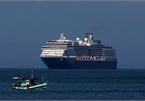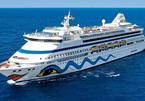A former passenger on the cruise ship MS Westerdam who tested positive for the Covid-19 coronavirus in Malaysia having left the vessel has led to fears that other passengers who have also moved on might have been exposed to the virus.
Efforts are now being made to track down those who have left the ship and Cambodia's decision to let the vessel dock - a move praised by the World Health Organization (WHO) - is now being questioned.
An outbreak on another cruise ship, the Diamond Princess which is quarantined off Japan, is the biggest infection cluster outside China with more than 600 confirmed cases.
How did the Westerdam end up in Cambodia?
The Westerdam was taking 1,455 passengers and 802 crew on a cruise around Asia.
It was heading to Japan, but was turned away. No-one on board was feeling unwell but the ship had previously docked in Hong Kong, which has been badly hit by the virus. That was enough to spark worries the virus could have found its way on board.
The cruise ship was then turned away by four other countries, but last Thursday it was finally allowed to dock in Sihanoukville, Cambodia. The WHO called it an "example of international solidarity".
What happened after it docked?
About 20 passengers had clinical tests on board because they were ill. But the vast majority had their temperature taken and filled out a form. Most of these passengers then left the boat.
One passenger - an 83-year-old US woman - took a plane to Malaysia along with 144 other passengers. She recorded a high temperature on landing in Kuala Lumpur and tested positive for the virus.
Only after that were the remaining passengers quarantined and clinically tested - but by then hundreds had already left.
Dr Asok Karup from the Infectious Diseases Care clinic in Singapore says all passengers should have been clinically screened and quarantined. He described the process of self-certifying on a form that they were symptom-free as "completely inappropriate".
Spending two weeks aboard the vessel did not count as a proper quarantine because passengers could have come into contact with an infected person at any point during that period, he added.
Westerdam's operator Holland America Line said there had been "no indication of COVID-19 on the ship" during its voyage. During the quarantine period it said it carried out temperature checks and health screenings.
But "ships are not designed for quarantine," Dale Fisher, professor in infectious diseases at the National University of Singapore and chair of the WHO's Global Outbreak Alert and Response Network, told the BBC.
"If passengers are allowed to socialise, then it is possible that the virus would continue to transmit during this period of quarantine. In a typical quarantine set-up there are basic comforts, regular temperature taking, and questioning, but no mixing of those quarantined."
"In my view quarantining on board a ship is suboptimal - it would be useful to keep details of all the travellers in case, there is a case later then people can be easily contacted."
Why did Cambodia's leader greet the passengers?
In Sihanoukville - a city with strong economic ties to China - the disembarking passengers were met with flowers and traditional Cambodian scarves by Prime Minister Hun Sen himself.
Neither the country's authoritarian leader nor anyone else in the welcoming party was wearing any protective gear, such as face masks.
Hun Sen had already expressed scepticism about the risks posed by the virus and offered to go personally to the Chinese city of Wuhan - the centre of the outbreak - to tell frightened Cambodians living there that they must stay put for the sake of relations with China, a vital ally for his country.
After that ostentatious welcome, some of passengers then began to be moved to the capital, Phnom Penh, from where some then continued their journeys.
Why did Cambodia take the risk?
Jonathan Head, BBC South East Asia Correspondent
Cambodia's Hun Sen saw the Westerdam as an opportunity. As an authoritarian ruler who has held office for 35 years, he did not have to worry about public criticism over allowing it to dock.
Also, by attracting so much attention to his offer he not only appeared generous, but also diverted media attention from the European Union decision the same week to withdraw vital trade privileges from Cambodia over the government's suppression of the political opposition.
Most of all it gave Hun Sen something he has wanted for a long time; a chance to repair relations with the US. These were badly frayed three years ago when the opposition leader Kem Sokha, who looked on course to beat Hun Sen in the 2018 election, was arrested and accused of plotting, with US backing, to overthrow the government.
Independent media were shut down, journalists arrested, and the US pro-democracy organisation NDI forced to close.
The current US ambassador Patrick Murphy has worked hard to improve ties since he was appointed in August last year. The need to get 650 Americans home off the Westerdam offered a chance to do that.
Where are the passengers now?
On Tuesday Holland America confirmed that all passengers still on board had tested negative.
The Westerdam would stay in port "for at least a few more days until testing is complete on the 747 crewmembers", the company said.
Of the several hundred passengers in hotels in Phnom Penh, some have already had negative tests returned and are free to leave, others are awaiting results.
It is thought that about 650 of the guests on board the ship were from the US, 270 from Canada, 130 from the UK, 100 from the Netherlands, 50 from Germany and several passengers from Australia.
The crew consisted largely of Indonesians and Filipinos.
What is being done in response?
Holland America says it has shared information on the passengers with the respective countries who can now try to get in touch with them.
The UK said it was offering consular assistance to British Westerdam passengers, asking them to get in touch.
Canada is asking all its citizens returning from the vessel to self isolate for 14 days once back home, local media report.
Malaysia has since said all other passengers from the Westerdam transiting in Kuala Lumpur had left the country and that it would not allow any more of the ship's guests to enter or transit.
Thailand has also barred Westerdam passengers from entering - but only after several had already arrived to Bangkok where they were being screened again.
Other countries such as Singapore have also said they won't allow any former Westerdam passengers to enter except for two of its citizens who have already returned and are in home quarantine. BBC

Coronavirus: 'Pariah' cruise ship rejected by five ports docks at last
More than 2,000 passengers on the US liner were stranded at sea because of virus fears.

Quang Ninh refuses to receive Italian cruise ship amid coronavirus spread
Authorities of the northern province of Quang Ninh have refused to welcome an Italian cruise ship with more than 1,000 tourists on board for fears of coronavirus infection.